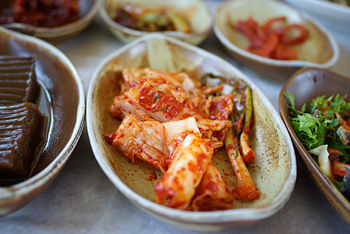Kimchi: Difference between revisions
imported>Chunbum Park m (→History) |
imported>Chunbum Park |
||
| Line 3: | Line 3: | ||
== History == | == History == | ||
The kimchi has its roots in the salted vegetables that were preserved as a source of food during the winter months. This practice existed in China and Korea some 3,000 years ago, and its method was later transferred to Japan by the Koreans from [[Baekje]].<ref name="kimchimuseumorigin">[http://www.kimchimuseum.co.kr/data/kimchi/kimchi_view.asp?m_id=3&page=1&m_no=24&str1=&str2= 김치의 변천사] [the history of kimchi], Pulmone Kimchi Museum. 2007-10-08.</ref> Accordingly it is theorized that the Koreans originally called the dish ''chimchae'', meaning "the salting of vegetable." The name underwent several phonetic changes over the centuries, to ''timchae'', ''dimchae'', ''jimchi'', and finally ''kimchi''.<ref name="historytourism">[http://english.visitkorea.or.kr/enu/FO/FO_EN_6_1_2_1.jsp History of Kimchi], Korea Sparkling. Date accessed: 2009-03-10</ref><ref name="historytourism2">[http://english.visitkorea.or.kr/enu/SI/SI_EN_3_6.jsp?gotoPage=1&cid=259613 Kimchi, the fundamental Korean food], Korea Sparkling. Date accessed: 2009-03-10</ref> The "kimchi" is first mentioned in the historical texts from the [[Goryeo Dynasty]], including guidelines and conventions that detailed a list of kimchi types that were necessary for ancestral rituals.<ref name="koreana>[http://koreana.kf.or.kr/pdf_file/2008/2008_WINTER_E006.pdf Kimchi], ''Koreana''. Winter 2008.</ref> | The kimchi has its roots in the salted vegetables that were preserved as a source of food during the winter months. This practice existed in China and Korea some 3,000 years ago, and its method was later transferred to Japan by the Koreans from [[Baekje]].<ref name="kimchimuseumorigin">[http://www.kimchimuseum.co.kr/data/kimchi/kimchi_view.asp?m_id=3&page=1&m_no=24&str1=&str2= 김치의 변천사] [the history of kimchi], Pulmone Kimchi Museum. 2007-10-08.</ref> Accordingly it is theorized that the Koreans originally called the dish ''chimchae'', meaning "the salting of vegetable." The name underwent several phonetic changes over the centuries, to ''timchae'', ''dimchae'', ''jimchi'', and finally ''kimchi''.<ref name="historytourism">[http://english.visitkorea.or.kr/enu/FO/FO_EN_6_1_2_1.jsp History of Kimchi], Korea Sparkling. Date accessed: 2009-03-10</ref><ref name="historytourism2">[http://english.visitkorea.or.kr/enu/SI/SI_EN_3_6.jsp?gotoPage=1&cid=259613 Kimchi, the fundamental Korean food], Korea Sparkling. Date accessed: 2009-03-10</ref> The "kimchi" is first mentioned in the historical texts from the [[Goryeo Dynasty]], including guidelines and conventions that detailed a list of kimchi types that were necessary for ancestral rituals. A medical journal from this period listed the main vegetables used to make kimchi: cucumber, wax gourd, garlic chives, curled mallow, lettuce, green onion, and radish.<ref name="koreana>[http://koreana.kf.or.kr/pdf_file/2008/2008_WINTER_E006.pdf Kimchi], ''Koreana''. Winter 2008.</ref> | ||
Revision as of 17:19, 28 June 2009
Kimchi (김치), also transliterated as "kimchee", is a family of Korean vegetable-based pickles. They are a basic part of Korean cuisine, with many variants, although usually strongly flavored, featuring garlic and hot peppers. Kimchi is a key ingredient for Korean dishes such as kimchi stew and kimchi pancake and is often eaten by Koreans with ramen noodles and gimbap rolls. The side dish is generally considered very healthy due to its lactic acid bacterias, antioxidants, and high fiber content. Although it is widely accepted that the advantages of eating kimchi include improved digestion and bowel function, other benefits, such as increased immunity and reduced chance of cancer, are disputed due to contradicting studies or lack of concrete evidence.[1] In 2008, the Health Magazine listed kimchi as one of the five healthiest foods in the world.[2]
History
The kimchi has its roots in the salted vegetables that were preserved as a source of food during the winter months. This practice existed in China and Korea some 3,000 years ago, and its method was later transferred to Japan by the Koreans from Baekje.[3] Accordingly it is theorized that the Koreans originally called the dish chimchae, meaning "the salting of vegetable." The name underwent several phonetic changes over the centuries, to timchae, dimchae, jimchi, and finally kimchi.[4][5] The "kimchi" is first mentioned in the historical texts from the Goryeo Dynasty, including guidelines and conventions that detailed a list of kimchi types that were necessary for ancestral rituals. A medical journal from this period listed the main vegetables used to make kimchi: cucumber, wax gourd, garlic chives, curled mallow, lettuce, green onion, and radish.[6]
"Summer kimchi" is made from leaves and cores of the cabbage family, while "winter kimchi" is based on white radishes of the daikon family.
Notes
- ↑ Koreans’ Kimchi Adulation, With a Side of Skepticism, Barbara Demick, Los Angeles Times, 2006-05-21.
- ↑ "World’s Healthiest Foods: Kimchi (Korea)", Joan Raymond, Health Magazine. 2008-02-01.
- ↑ 김치의 변천사 [the history of kimchi], Pulmone Kimchi Museum. 2007-10-08.
- ↑ History of Kimchi, Korea Sparkling. Date accessed: 2009-03-10
- ↑ Kimchi, the fundamental Korean food, Korea Sparkling. Date accessed: 2009-03-10
- ↑ Kimchi, Koreana. Winter 2008.
